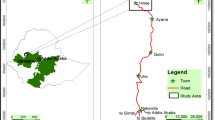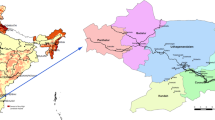Abstract
The Landslide happens in mountainous regions due to the catastrophe of slope through intensive rain and seismicity. The Himalayas is one of the susceptible parts of the world in the perspective of slope catastrophe hazard; i.e., Mass Movement, especially Neelum valley is considerable destruction of community infrastructure, highway, and critically disturbed the tourism segment. Landslide is a common and recurrent phenomenon in the northern mountainous terrain of Pakistan such as District Neelum. After the 2005 Kashmir earthquake, the importance of landslide investigation is increasing. The purpose of this research is to establish a brief landslide inventory and to determine the relationship of landslides with causative factors by spatial distribution analysis. With the aid of Google Earth imageries and field visits, a total of 618 landslides were identified in the study area of 3621 km. These landslide localities compared with causative factors. Finally, distribution maps are generated and analyse their feature class through Digital Elevation Model and ArcGIS. Landslide intensity is calculated in terms of landslide concentration. Landslide concentration (LC) is significantly found very high in slope gradient less than 30 (1.21) and the first 100 m zone around the road network (15.06). A bit higher landslide frequency is noted in east orienting slopes. In the first 100 m, zone road network and drainage networks are 83.49% and 62.78% of the total landslide occurs having LC value 4.6, respectively. The analysis shows that the steep slopes, an area closer to the road network, drainage network, barren lands, and Quaternary alluvium of loose material are more susceptible to landslides. In addition, a landslide classification map is also prepared on the basis of field observation that shows that debris slides are more dominating.



(Source: AKMIDC)

















Similar content being viewed by others
References
Abbasi A, Khan MA, Ishfaq M, Mool PK (2002) Slope failure and landslide mechanism in Murree area, North Pakistan. Geol Bull Univ Peshawar 35:125–137
Agliardi FN et al (2009) Integrating rockfall risk assessment and countermeasure design by 3D modelling techniques. Natural Hazards Earth Syst Sci 9(4):1059
Ali FN et al (2017) Structural and climatic control of mass movements along the karakoram highway. Advancing culture of living with landslides. Springer, Cham, pp 509–516
Ayalew L, Yamagishi H (2005) The application of GIS-based logistic regression for landslide susceptibility mapping in the Kakuda-Yahiko Mountains. Central Japan Geomorphology 65(1–2):15–31
Ayalew L, Yamagishi H, Ugawa N (2004) Landslide susceptibility mapping using GIS-based weighted linear combination, the case in Tsugawa area of Agano River, Niigata Prefecture. Japan Landslides 1(1):73–81
Baig MS, Lawrence RD (1987) Precambrian to Early Paleozoic orogenesis in the Himalaya. Kashmir Journal of Geology 5:1–22
Barredo FN et al (2000) Comparing heuristic landslide hazard assessment techniques using GIS in the Tirajana basin, Gran Canaria Island, Spain. Int J Appl Earth Obs Geoinf 2(1):9–23
Basharat M (2012) The distribution, characteristics and behaviour of mass movements triggered by the Kashmir Earthquake 2005. NW Himalaya, Pakistan
Basharat M, Rohn J (2015) Effects of volume on travel distance of mass movements triggered by the 2005 Kashmir earthquake, in the Northeast Himalayas of Pakistan. Nat Hazards 77(1):273–292
Bibi FN et al (2016) Landslide susceptibility assessment through fuzzy logic inference system (flis). Int Archiv Photogramm Remote Sens Spat Info Sci 42:355
Bouhadad Y, Benhamouche A, Bourenane H, Ouali AA, Chikh M, Guessoum N (2010) The Laalam (Algeria) damaging landslide triggered by a moderate earthquake (M w= 5.2). Nat Hazards 54(2):261–272
Brawner and Wyllie (1976). Rock slope stability on railway projects. Area Bulletin, 77(Bulletin 656).
Buss K et al. (1995) Highway rock slope reclamation and stabilization, black hills region, South Dakota, Part II, guidelines. Final Report.
Calkins JA. et al. (1975) Geology of the southern Himalaya in Hazara, Pakistan, and adjacent areas. US Govt. Print. Off
Carrara A, Guzzetti F, Cardinali M, Reichenbach P (1999) Use of GIS technology in the prediction and monitoring of landslide hazard. Nat Hazards 20(2–3):117–135
Chau FN et al (1998) Rockfall problems in Hong Kong and some new experimental results for coefficients of restitution. Int J Rock Mech Min Sci 35(4–5):662–663
Cruden DM, Varnes DJ (1996) Landslide types and processes in Landslides: investigation and mitigation. In: Turner AK, Schuster RL (Ed), Transportation Research Board, Special Report No. 247, p. 36-75
Cruden, D. M. & Varnes, D. J. (1996). Landslides: investigation and mitigation. Chapter 3-Landslide types and processes. Transportation Research Board Special Report, p. 247.
Freeman P (2002) Catastrophes and development: Integrating natural catastrophes into development planning.
Greco A (1989) The crystalline rocks of the Kaghan Valley (NE-Pakistan). Eclogae Geologicae Helvetiae 82:629–653
Haines FN et al (2006) Climate change and human health: impacts, vulnerability and public health. Public Health 120(7):585–596
Hewitt K (1999) Quaternary moraines vs catastrophic rock avalanches in the Karakoram Himalaya, northern Pakistan. Quatern Res 51(3):220–237
Highland L, Bobrowsky PT (2008) The landslide handbook: a guide to understanding landslides. US Geological Survey Reston.
Hussain A, Khan MR, Malik NA, Amin M, Shah MH, Tahir MN (2017) GIS based mapping and analysis of landslide hazard’s impact on tourism: a case study of Balakot valley, Pakistan.
Hutchinson JH (1988) General report, morphological and geotechnical parameters of landslides in relation to geology and hydrogeology. In: Landslides, Proceedings of the Fifth International Symposium on Landslides, 1988.
Jadoon IAK, Hinderer M, Kausar AB, Qureshi AA, Baig MS, Basharat M, Frisch W (2015) Structural interpretation and geo-hazard assessment of a locking line: 2005 Kashmir Earthquake, western Himalayas. Environ Earth Sci 73(11):7587–7602
Kamp U, Growley BJ, Khattak GA, Owen LA (2008) GIS-based landslide susceptibility mapping for the 2005 Kashmir earthquake region. Geomorphology 101(4):631–642
Kanwal FN et al (2017) GIS based landslide susceptibility mapping of northern areas of Pakistan, a case study of Shigar and Shyok Basins. Geomat Nat Hazards Risk 8(2):348–366
Keefer DK (1984) Landslides caused by earthquakes. Geol Soc Am Bull 95(4):406–421
Khan AN (2000) Landslide hazard and policy response in Pakistan: a case study of Murree. Pakistan Sci Vis 6(1):35–48
Kiani MJ, Abbasi MK, Rahim N (2005) Use of organic manure with mineral N fertilizer increases wheat yield at Rawalakot Azad Jammu and Kashmir. Archiv Agron Soil Sci 51(3):299–309
Soomro et al. (2012). A Conceptual Model for identifying Landslide risk: A case study Balakot, Pakistan. Sindh University Research Journal-SURJ (Science Series), 44(2).
Maerz FN et al (2015) Remediation and mitigation strategies for rock fall hazards along the highways of Fayfa Mountain, Jazan Region, Kingdom of Saudi Arabia. Arab J Geosci 8(5):2633–2651
Mughal MS, Khan MS, Khan MR, Mustafa S, Hameed F, Basharat M, Niaz A (2016) Petrology and geochemistry of Jura granite and granite gneiss in the Neelum Valley, Lesser Himalayas (Kashmir, Pakistan). Arab J Geosci 9(8):528
Naseer S, Ahmad D, Hussain Z (2019) Petrographic, physical and mechanical properties of sandstone of mirpur district area state of AJ&K. Pakistan Earth Sci Malaysia 3(2):32–38
Nefeslioglu HA, Gokceoglu C, Sonmez H (2008) An assessment on the use of logistic regression and artificial neural networks with different sampling strategies for the preparation of landslide susceptibility maps. Eng Geol 97(3–4):171–191
Norini G et al (2016) (2016). Delineation of alluvial fans from digital elevation models with a GIS algorithm for the geomorphological mapping of the Earth and Mars. Geomorphology 273:134–149
Owen LA, Kamp U, Khattak GA, Harp EL, Keefer DK, Bauer MA (2008) Landslides triggered by the 8 October 2005 Kashmir earthquake. Geomorphology 94(1–2):1–9
Petley D, Dunning S, Rosser N, Kausar AB (2006) Incipient landslides in the Jhelum Valley, Pakistan following the 8th October 2005 earthquake. Messages V.
Pierson LA et al. (1993) Rockfall hazard rating system-participants’manual.
Regmi FN et al (2016) Rock fall hazard and risk assessment along Araniko Highway. Central Nepal Himalaya Environ Earth Sci 75(14):1112
Riaz MT, Basharat M, Hameed N, Shafique M, Luo J (2018) A data-driven approach to landslide-susceptibility mapping in mountainous terrain: Case study from the northwest himalayas, Pakistan. Nat Hazard Rev 19(4):5018007
Romana M (1985) New adjustment ratings for application of Bieniawski classification to slopes. In: Proceedings of the International Symposium on Role of Rock Mechanics, Zacatecas, Mexico, p. 49–53.
Sandyavitri A (2016) Developing and selecting slope stabilization techniques in managing slope failures. Jurnal Teknik Sipil 12(4)
Sarwar FN et al (2016) Earthquake Statistics and Earthquake Research Studies in Pakistan. Open Journal of Earthquake Research 5(02):97
Sato HP et al (2007) Interpretation of landslide distribution triggered by the 2005 Northern Pakistan earthquake using SPOT 5 imagery. Landslides 4(2):113–122
Sato HP, Hasegawa H, Fujiwara S, Tobita M, Koarai M, Une H, Iwahashi J (2007) Interpretation of landslide distribution triggered by the 2005 Northern Pakistan earthquake using SPOT 5 imagery. Landslides 4(2):113–122
Shafique M, van der Meijde M, Khan MA (2016) A review of the 2005 Kashmir earthquake-induced landslides; from a remote sensing prospective. J Asian Earth Sci 118:68–80. https://doi.org/10.1016/j.jseaes.2016.01.002
Shahabi H, Hashim M, Ahmad BB (2015) Remote sensing and GIS-based landslide susceptibility mapping using frequency ratio, logistic regression, and fuzzy logic methods at the central Zab basin. Iran Environmental Earth Sciences 73(12):8647–8668
Sudmeier-Rieux K, Qureshi RA, Peduzzi P, Jaboyedoff MJ, Breguet A, Dubois J, Jaubert R, Cheema MA (2007) An interdisciplinary approach to understanding landslides and risk management: a case study from earthquake-affected Kashmir. Mountain Forum, Mountain GIS e-Conference, January 14–25, 2008.
Taherynia MH et al (2014) Assessment of slope instability and risk analysis of road cut slopes in Lashotor Pass, Iran. J Geol Res 2014:1–12
Tan Q, Wang P, Hu J, Zhou P, Bai M, Hu J (2020) The application of multi-sensor target tracking and fusion technology to the comprehensive early warning information extraction of landslide multi-point monitoring Data. Measurement 166:108044
Uzielli FN et al (2008) A conceptual framework for quantitative estimation of physical vulnerability to landslides. Eng Geol 102(3–4):251–256
Wadia DN (1931) The syntaxis of the northwest Himalaya: Its rocks, tectonics and orogeny. Records Geol Survey India 65:189–220
Waseem M, Lai CG, Spacone E (2018) Seismic hazard assessment of northern Pakistan. Nat Hazard 90(2):563–600. https://doi.org/10.1007/s11069-017-3058-1
Xu C, Xu X, Shyu JBH, Zheng W, Min W (2014) Landslides triggered by the 22 July 2013 Minxian-Zhangxian, China, Mw 5.9 earthquake: inventory compiling and spatial distribution analysis. J Asian Earth Sci 92:125–142
Yalcin A, Reis S, Aydinoglu AC, Yomralioglu T (2011) A GIS-based comparative study of frequency ratio, analytical hierarchy process, bivariate statistics and logistics regression methods for landslide susceptibility mapping in Trabzon. NE Turkey Catena 85(3):274–287
Zhou Q, Xu Q, Peng D, Fan X, Ouyang C, Zhao K, Li H, Zhu X (2020) Quantitative spatial distribution model of site-specific loess landslides on the Heifangtai terrace, China. Landslides. https://doi.org/10.1007/s10346-020-01551-y
Author information
Authors and Affiliations
Corresponding author
Additional information
Publisher's Note
Springer Nature remains neutral with regard to jurisdictional claims in published maps and institutional affiliations.
Rights and permissions
About this article
Cite this article
Naseer, S., Haq, T.U., Khan, A. et al. GIS-based spatial landslide distribution analysis of district Neelum, AJ&K, Pakistan. Nat Hazards 106, 965–989 (2021). https://doi.org/10.1007/s11069-021-04502-5
Received:
Accepted:
Published:
Issue Date:
DOI: https://doi.org/10.1007/s11069-021-04502-5




